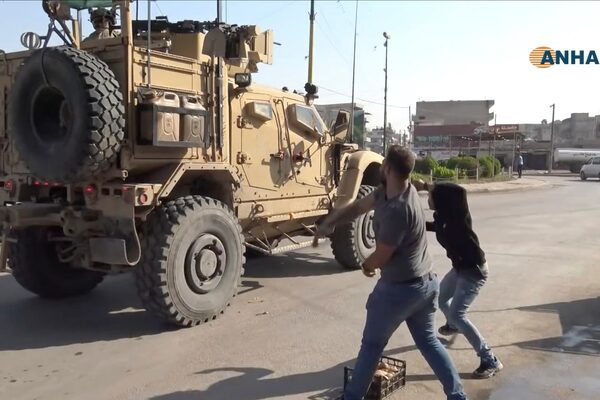
In this frame grab from video provided by Hawar News, ANHA, the Kurdish news agency, residents who are angry over the U.S. withdrawal from Syria hurl potatoes at American military vehicles in the town of Qamishli, northern Syria, on Oct. 21, 2019.The Associated Press
The man in the white T-shirt stood in front of the U.S. military convoy, blocking it long enough for the American soldiers to read the English words scrawled on his handmade sign: “Trump betrayed us.”
The man in white stepped aside after a few seconds, knowing he couldn’t stop the U.S. retreat from eastern Syria that had been ordered by President Donald Trump. But a video of the scene was shared on Twitter by a spokesman for the Syrian Democratic Forces, a predominantly Kurdish militia that fought alongside the United States to defeat the Islamic State.
The SDF’s distribution of the video highlighted the anger Syrian Kurds feel at being abandoned to their fates by Mr. Trump. After a five-day ceasefire, Turkey is expected on Tuesday to resume a military offensive aimed at creating a 30-kilometre deep “buffer zone” – free of Kurdish fighters – across its border with Syria.
Syrian Kurds in the town of Qamishli, which is within the zone the Turkish offensive seeks to capture, displayed their anger Monday by throwing potatoes at a line of departing U.S. Humvees. “America, liar!” one man shouted at the withdrawing troops, in another moment captured on video. Some used far less polite terms to berate their erstwhile protectors.
“It’s unprecedented that Kurds feel so much apathy – and show so little respect to Americans,” said Shivan Fazil, a political analyst based in Erbil, the capital of the Kurdish autonomous region in neighbouring Iraq.
After more than 16 years of fighting side-by-side with the U.S. – first against former Iraqi dictator Saddam Hussein, more recently against Islamic State in a fight that took place on both sides of the Iraq-Syria border – Mr. Fazil said many Kurds felt betrayed by Mr. Trump’s abrupt decision to pull U.S. troops from Syria, which the President announced following an Oct. 6 phone conversation with Turkish President Tayyip Recep Erdogan.
Syria’s estimated two million Kurds fear what happens after the last of the 1,000 or so American troops who had been deployed alongside the SDF depart Syria (though U.S. Defence Secretary Mark Esper said Monday that some troops might be left behind to guard the region’s oil fields). Turkey has vowed to resume its offensive unless all Kurdish fighters laid down their weapons and withdrew from the buffer zone by the end of the ceasefire, which was negotiated last week during a meeting between Mr. Erdogan and U.S. Vice-President Mike Pence.
The SDF said on Monday that it had left the battle-scarred town of Ras al-Ayn, near the Turkish border. However, there was no sign that Kurdish fighters had pulled back from other towns in the region.
“If they don't withdraw, our operation will resume. This is also what we agreed with the Americans,” Turkish foreign minister Mevlut Cavusoglu told a forum Monday in Istanbul.
Turkey sees the SDF as a rebranded version of a Kurdish militia called the YPG – which is itself allied with the Kurdistan Workers’ Party, or PKK, which has fought a decades-long struggle for independence from Ankara for Turkey’s own 12 million-strong Kurdish population. Turkey considers the PKK a “terrorist” group.
The U.S. withdrawal and Turkish offensive have already brought an end to the de facto autonomy that Syrian Kurds have enjoyed east of the Euphrates River since the defeat of Islamic State this year. The Kurds, who have also been battling Syrian President Bashar al-Assad’s regime since civil war erupted in the country eight years ago, last week invited Mr. al-Assad’s forces – which are backed by Russian air power – to enter parts of northeast Syria for the first time since 2012, under an agreement meant to block the Turkish invasion.
It was unclear Monday whether Turkey would seek to create the 30-kilometre buffer zone anyway, and what Russian and Syrian forces might do to stop them. Many Syrian Kurds will also be unhappy to see the return of Mr. Assad’s iron-fisted rule to the rest of the region.
Mr. Erdogan was set to fly to the Russian resort town of Sochi on Tuesday, ahead of the expiration of the ceasefire, to negotiate with Russian President Vladimir Putin. “We will take up this process with Mr. Putin and after that we will take the necessary steps,” Mr. Erdogan said.
The hasty U.S. withdrawal has confirmed Mr. Putin’s status as the key power broker in Syria. Transport planes carrying Russian soldiers arrived in Qamishli just hours after the departing American troops were pelted with potatoes.
At least 477 people have been killed since the Turkish offensive began on Oct. 9, according to the independent Syrian Observatory for Human Rights. The United Nations says more than 176,000 people have been forced from their homes.
Meanwhile, the government of the Kurdish autonomous region in northern Iraq was scrambling to prepare for an anticipated refugee influx. Several thousand Syrian Kurds have already arrived in the region, and the local government said over the weekend that it was expecting as many as 250,000 people to flee from Syria to Iraq if the Turkish offensive resumed.
The conflict has strained ties between Turkey and the rest of the 29-member NATO alliance, with several countries – including France and Germany – backing their criticism of the Turkish offensive by suspending military sales to Ankara.
Our Morning Update and Evening Update newsletters are written by Globe editors, giving you a concise summary of the day’s most important headlines. Sign up today.
 Mark MacKinnon
Mark MacKinnon